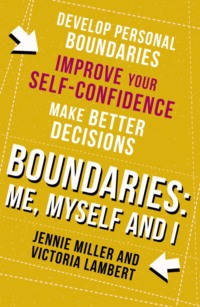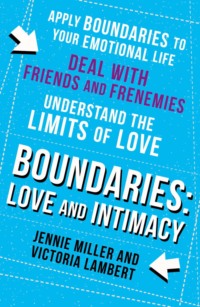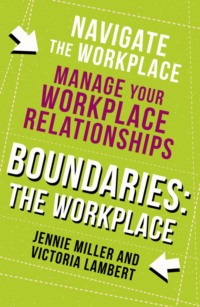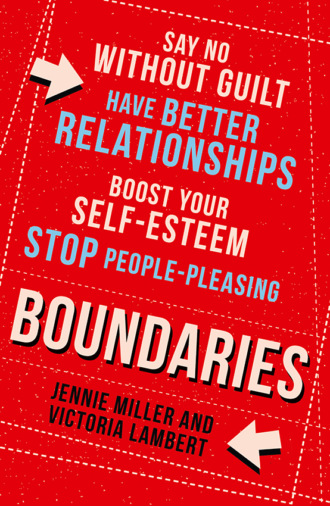
Полная версия
Boundaries: Say No Without Guilt, Have Better Relationships, Boost Your Self-Esteem, Stop People-Pleasing

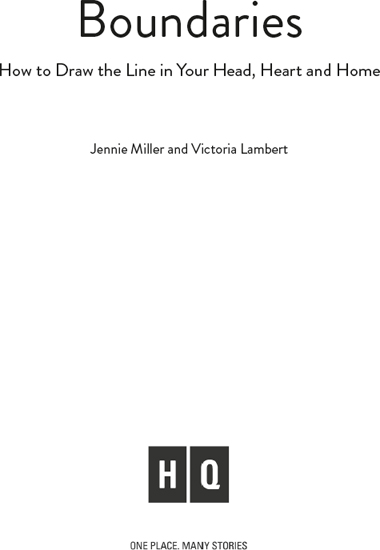

An imprint of HarperCollinsPublishers Ltd.
1 London Bridge Street
London SE1 9GF
First published in Great Britain by HQ in 2018
Copyright © Jennie Miller and Victoria Lambert 2018
Jennie Miller and Victoria Lambert asserts the moral right to be identified as the author of this work.
A catalogue record for this book is available from the British Library.
This novel is entirely a work of fiction. The names, characters and incidents portrayed in it are the work of the author’s imagination. Any resemblance to actual persons, living or dead, events or localities is entirely coincidental.
All rights reserved under International and Pan-American Copyright Conventions. By payment of the required fees, you have been granted the non-exclusive, non-transferable right to access and read the text of this e-book on-screen. No part of this text may be reproduced, transmitted, downloaded, decompiled, reverse engineered, or stored in or introduced into any information storage and retrieval system, in any form or by any means, whether electronic or mechanical, now known or hereinafter invented, without the express written permission of HarperCollins.
Ebook Edition © December 2017 ISBN: 9780008240837
Version: 2018-07-10
CONTENTS
Cover
Title Page
Copyright
Introduction
STEP ONE: ME, MYSELF, I
How to develop personal boundaries to improve your self-confidence and help you make better decisions in the most intimate aspects of your life.
Sleep
Fitness
Eating Habits
Unhealthy Habits
Social Media and E-mail Protocol
Your Self-Boundaries and Others
The Drama Triangle
STEP TWO: THE WORKPLACE
Building on your new skills, you will learn to navigate the workplace and those within it.
Employment Tribes
The Workplace Culture
Office Romances
The Family CEO
The Winner’s Triangle
STEP THREE: LOVE AND INTIMACY
Having learnt to negotiate your position in the workplace, now’s the time to apply boundaries to your emotional life.
Love Limits
Staying In Love
Love Leaving
Looking For Love
Friends and Frenemies
STEP FOUR: YOUR FAMILY AND OTHER ANIMALS
Possibly the most challenging section, in this step you will learn how to use boundaries in connection with those who shaped you first: your parents or other caregivers in particular, before gathering the skills you need to bring up your own children and interact with your wider family.
Parents/Elders
Children
Adolescents
Blended Families
Siblings
APPENDIX 1
Transactional Analysis: An Overview
APPENDIX 2:
Strokes
Acknowledgements
Index
About the Publisher
Introduction
Do you often feel you can’t say no? Do you feel spread too thinly between work, emotional relationships and family, and your responsibilities and chores? Perhaps you feel overloaded with to-do lists, promises to friends, financial obligations, or that intangible pressure to succeed in everything you do all at the same time. You may feel frustrated that there is never any time to do those things that really matter to you – whether it is to write a book, spend unpressured time with your loved ones, or just be alone guilt-free. With demands coming from all sides, it is surprisingly easy these days to get buffeted along without ever really feeling in control.
Yet, there is an alternative to living in this twenty-first-century chaos – a way of reframing your own attitude and behaviour so that you can take charge of your life and not allow others undue influence or control. A process which will enable you to improve your quality of life (at work, home and play); to build self-respect; and to lead to a healthier way of being on all levels.
The solution to all this is: boundaries. A complete concept that will allow you to reach past any obstacle and make real change happen in every area of your life.
What are boundaries? In short, these are the decisions we make which govern our own behaviour and the way we interact with others. A sort of personal code which may change with time and circumstance. We’ll explain the concept of boundaries in more depth in the next section but for now hold in mind that a boundary is where you choose to draw a line in the sand in any scenario.
Why do they matter? Because we can’t just follow patterns of behaviour that worked for previous generations as life on this planet has changed beyond recognition in the past thirty years. We are now a 24/7 culture, invisibly connected from our homes to the entire world.
We live in the fast lane, yet few of us have developed strategies to cope with the new problems that have arisen as a result. These issues include burgeoning social media, high-speed and high-turnover lovers, growing workloads in the face of new technology, constantly conflicting opinions on diet and health, and a culture of perfectionism in parenting and relationships. There are familiar problems too which many of us still struggle with: the impact of divorce, personality clashes, the stresses of being caught in the generation gap and career dilemmas.
But there is no doubt that the arrival of the Internet, consumer society, medical advances that are giving us decades of extra life and career expectations have changed life as older generations knew it beyond belief. The way we humans interact with each other has also undergone fundamental shifts, and we believe the way to regain our own equilibrium is to re-examine our lives and behaviour and use fresh boundaries in response to these new dilemmas.
With that in mind, we have devised a Four-Step Programme to teach the use of boundaries in everyday life, beginning with ourselves, and then exploring how the system works in situations related to every aspect of our lives: ourselves, our work life, our relationships and our family. We advise you to follow the Programme in the order set out in the book, although some may find particular sections are more resonant or urgent in their circumstances. Everyone, though, will benefit by starting with a closer look at themselves – and what we call our ‘self-boundaries’.
What do we mean by that? Self-boundaries are the demarcations which define our behaviour, thoughts and feelings. They are that inner voice which says to us: ‘Go this far but no further.’ When used correctly, they help us modify our behaviour or relationships so that we feel or consider ourselves safe. And we need to get into the habit of caring for our ‘selves’ before we can build the healthy relationships with others that will see us thrive.
Each section of the book will contain exercises and sections called Bring in the Boundaries which contain practical tips on identifying and using boundaries, and offer anonymised case histories from Jennie’s clinical practice to exemplify what you need to know. These examples help us to understand how boundaries work in specific circumstances, from dating to divorce, interacting with elderly parents to raising teenagers and managing a team to working for a fractious boss. (The situations chosen have been picked deliberately because in Jennie’s experience they’re the ones most people need help addressing and have the highest impact on lives.) Look out, too, for ‘Draw the Line’ moments – thoughts and phrases which will support and inspire you as you progress through the book.
There is no timescale for this book because we all work at our own pace, so don’t feel you have to achieve this new state of being overnight. The first step towards a healthy you may well be in accepting that you can’t change your life instantly. But as you read this you are already starting on that journey.
What are Boundaries?
Like many psychotherapists and proponents of healthy living, Jennie believes that learning to establish good boundaries is crucial to forming and keeping healthy relationships, with yourself and others. And you may well have heard the term ‘boundaries’ used out loud already – even if you don’t really know what it means – phrases like ‘I need to establish good boundaries for my child around bedtime’ or someone telling you that ‘your work–life balance needs some boundaries.’
But the need to understand and utilise boundaries has never been more acute, and existing advice doesn’t cover many of the situations we now accept and deal with every day.
For example, our fast-paced lives require us to make more decisions than in the past, often quickly – yet with potentially serious consequences. The challenges to our boundaries are more complex and demanding, and we all need new strategies on how to live life as healthily as possible.
The effect of technology on our boundaries is particularly important when it comes to conversations and relationships. These used to be straightforward but now are more difficult because of the lack of face-to-face contact. Situations can easily be misread, moods can be misinterpreted and remarks can be misconstrued when you remove the physical presence of human contact.
The 24/7 culture of e-mails and the Internet means we can never switch off. We are no longer able to pull up the mental drawbridge – we are always vulnerable to what feels like outside pressures and invasions. Some of this attention is not unwelcome, we encourage it ourselves. But that doesn’t mean our boundaries are healthy; it may mean we don’t recognise what can hurt us.
The inspiration for this book came about through a conversation we shared on the subject of e-mail communication. In a steamy coffee shop full of post-school run parents and busy workers grabbing a latte to go, we found ourselves catching up on life, work, family and friends. During our chat, Victoria mentioned a familiar dilemma she was struggling with – she had been asked to help with a function which she had neither the time, energy, or the desire to do. However, she felt a strong pull to be useful and the resulting emotion was guilt. Jennie identified her problem as being a lack of boundaries and explained the concepts that underpin them (as we will explore in this book).
Victoria went home inspired and wrote an e-mail explaining to a colleague why she couldn’t help at the function. She wrote:
‘I am so sorry to say that I feel I cannot help with your plans towards putting on this event. I am really busy with work and childcare at the moment, so am finding it hard to make time. Obviously, I will still do what I can to be useful, and don’t forget to ask me to invite those people we mentioned, but I think that will have to be my input for now. Do call if I can do anything else.’
Then she thought again about Jennie’s explanation of boundaries, and realised she wasn’t being honest. Moreover, she was soft-soaping her decision because she felt guilty – which was confusing the issue, not clarifying it. Several long phone calls with Jennie followed as Victoria was feeling uncomfortable and anxious about the potential response. Jennie encouraged her to be brave and brief.
This was her second draft (with self-boundary): ‘I won’t be available to help with your event. I know it will be a huge success, and wish you well.’
And the response to that second e-mail: ‘Fair enough. Thank you for letting me know. Do come if you can.’
What Victoria found was that waiting for a response to a boundaried e-mail can feel nail-biting. However, as can be seen from the reply, others usually respond surprisingly well to a clear and no-nonsense message.
Think back to the last time you received a clear, concise e-mail. Wasn’t it refreshing and easier to engage with?
You need to know that your boundaries are in your control. You have the ability to decide when and how to draw the line in your life. This will be one of the most empowering lessons you ever learn.
How to Picture a Boundary
Depending on your personality and outlook, you may think of a boundary as an encircling brick wall or perhaps a fresh-looking picket fence with a gate always propped open, but we’d like to invite you to also think of your personal boundary in quite a different way.
Consider human skin. It’s dense enough to protect and contain us, but flexible enough to allow for movement. Skin is porous in the upper layers so what’s necessary can pass through – sweat can be excreted and sunshine absorbed to help us make vitamin D. Skin is also sufficiently tough to withstand accidental damage, and it’s capable of amazing re-growth.
As with skin, we can feel discomfort – even temporary pain at times – when boundaries get damaged either internally or from the outside when we don’t take care. Yet, again like our skin, boundaries are amazing because they can grow with us.
Why have we chosen to use skin as a metaphor? Because skin keeps us in contact with others – it’s not a brick wall or other type of opaque barrier. Studies show that skin-to-skin contact is actually vital for humans. Think of the studies which have shown that ‘kangaroo care’ – the nestling of a naked newborn on its parents’ bare chests – improves outcomes in premature baby care. And equally our skin can act as an early warning system for our entire bodies. Think of how your skin prickles when another person gets too close – it’s a very physical sensation.
Now, let’s look at your own personal boundaries.
EXERCISE: Your Personal Boundary
You will need another person to do this exercise with you. This other should be a friend or colleague but not someone with whom you are very close. We understand this may not feel easy, and you would be more comfortable with someone more familiar to you. But in close relationships, boundaries will be well established. We need you to step outside your comfort zone in order to experience a fresh boundary.
Begin by standing facing each other a comfortable distance apart – this might be four foot away from each other, or more or less.
You are going to stay on your spot. Notice the distance that feels comfortable. Now ask your exercise partner to step closer. They are now in charge of their movements and are gradually going to take one step at a time towards you, pausing for 30 seconds between each step. In that pause, consider how comfortable you feel.
As they come closer, note when you start to feel some level of discomfort. And when do you notice you are really not happy, and that your skin is starting to throw up a few goosebumps? When do you want to scream ‘stop’ – because your personal space now feels properly invaded? At that point ask your partner to step back.
So, what just happened?
This is your body unconsciously registering where it feels most comfortable in relation to another person. This is your discernible physical boundary. Bear this in mind as you read through the book – who oversteps this boundary and who stays too far away?
We suggest you have a notebook to hand while you go through the book so you can write down your experience of exercises like this and ideas that you want to make a note of so you can build up your own Learning Journal as you work through the book.
Part of understanding how to use boundaries is learning to look at interpersonal relationships and your own part in them. Then, deciding where and how to establish a boundary doesn’t just get easier, it becomes self-evident. The exercise above is your first step towards this.
Developing confidence in your own decision-making and its effect on your behaviour will make you happier as it means you are properly owning and taking care of yourself. In our experience: boundaries can give peace of mind. Boundaries give freedom. Boundaries are bliss.
STEP ONE: ME, MYSELF, I
‘The greatest discovery of all time is that a person can change his future by merely changing his attitude.’
OPRAH WINFREY
It is so important that you care for yourself first before you decide how much you can give to or care for another. Self-care is not selfish or even self-centred – quite the opposite. Remember when you get on a plane how the flight attendants tell you – in the case of emergency – to put on your own oxygen mask first, before helping others?
That’s a practical example of self-care – which is clearly aimed at a wider good. Setting self-boundaries is not about ignoring the needs of others, it’s about not ignoring yourself.
Take a minute to notice your reactions to what you have just read. What are your thoughts and feelings? When you read about the oxygen mask, does that make sense?
Can you think of a recent example of an occasion when you have put yourself first? Perhaps it was having an early night when others expected you to stay up to help or entertain them. Maybe you can’t think of an example, but you may know someone who seems confident in putting their needs first (but whom you don’t think of as selfish). You might view them as ‘sorted’ or ‘in control’. Write these initial thoughts down in your Learning Journal.
In Step One, we will learn to create and/or strengthen our personal boundaries which affect sleep, fitness, unhealthy habits, social media and e-mail and our attitude to our ‘self’ in general. We will also introduce a concept called the ‘Drama Triangle’, which explains how you interact with others.
In Jennie’s clinical practice, many clients come with an array of real problems involving other people – such as spouses or children – but what is often underlying is a lack of self-care and a surprising lack of awareness of their own needs. Encouraging them to focus on themselves first makes it easier to tackle their issues with others.
We all benefit from a bit of time and space to reflect on our lives and ourselves. And this book isn’t a replacement for therapy or suggesting anyone needs it. But Jennie knows from more than twenty years in practice – working all over the UK – there are many recurring personal and emotional issues which boundaries can help with.
Have you ever reflected on your personal rules for life – those that dictate things like our bedtimes, eating habits, manners and attitudes to relationships, which all develop over time. These are our ‘self-boundaries’ – and they primarily affect us (though they may well have a knock-on effect on others).
Here, we’ll be exploring our key self-boundaries and explaining how we can set them, taking into account our practical and emotional needs. This is a holistic approach to life – getting into the habit of caring for ourself in all regards. Treating ourself with respect and kindness will change the way we live, before we even start improving relationships with those around us.
We’re going to put you back in charge of your own life, before we go on to explaining how to use boundaries with others.
EXERCISE: Visualise Your Boundary (Listen to this exercise here)
Read through the following, then start.
Sitting in a comfy chair, take a few deep breaths and close your eyes. Settle yourself. Notice your breathing throughout the exercise.
Now, picture yourself stood in a large field. It is a beautiful sunny day, with blue sky, birds singing and lush green grass underfoot. Take a good look around your field and notice where you are in the field.
As you stand there, imagine that a boundary appears around you. What does it look like? What is it made of? How wide is it? How tall? Is it the same all the way around? Are there doors or windows? How do you feel within your boundary?
Now, imagine your field is becoming populated first with your family, then friends, then work colleagues, and finally everyone in your life, some closer, some further away. The boundary stays in place, but some may be within it and some outside.
Note again how you feel inside your boundary. Who is near to you, and who is far away?
Then open your eyes.
Go to your Learning Journal and answer these questions (you may want to draw rather than write your response): What does your boundary look like? Can you describe it? How did you feel when you were inside it? Did you feel safe, trapped, or lonely? Was there a difference between how you felt when there was and wasn’t a boundary? What was it like when the other people appeared in your field? What’s your view on your boundary? Does it feel secure? Does it allow you to be in contact with others or is it too rigid?
Are you surprised at your responses? Looking back at this boundary, would you consider it to be good enough? If not, write down what that ‘perfect’ boundary might look like. For example, if the boundary that first came into your mind had a perimeter of barbed wire, would you prefer it to be a natural, more porous hedge? It’s useful to do this exercise and imagine a physical boundary, but don’t worry – this mental picture can and will change as you become more confident of your needs.
So, why do your own boundaries matter in the context of others’ behaviour? Let’s consider Robinson Crusoe, Daniel Defoe’s famous castaway, who chose to live to a routine that helped him – in his own words – ‘stay sane’. With no one around him to impose boundaries, rules, or expectations on him, his survival – and happiness – depended on him making and keeping promises to himself in terms of behaviour.
But how would anyone fare on a desert island with no self-rules? Think of an alternative destination: the location in Lord of the Flies, William Golding’s novel of 1954. In this book, a group of young boys are marooned on an island and must find their own way in order to survive. One of the older boys, Piggy, appeals to reason, ‘Which is better – to have rules and agree, or to hunt and kill? … law and rescue, or hunting and breaking things up?’ But the other children – who don’t display any personal boundaries – do not know how to control their impulses, and soon individual lives and the group’s salvation are threatened.
Which island would you rather live on? One which is governed by good sense, responsible behaviour and self-care or the other, which has the false attraction of there being no boundaries? This feels like the ultimate freedom, but descends in time to anarchy and survival of the fittest.
EXERCISE: The Debating Table
In this exercise, we are going to show you how to identify their ‘self’. Our inner voice or sense of self is multi-faceted. Everyone has competing thoughts, feelings and beliefs which influence their conscious choices; you will have been accumulating these (often without knowing) since birth. Some we take heed of more than others. This exercise is about learning to listen to your whole ‘self’ before you make a decision – not just the voices that shout loudest.




